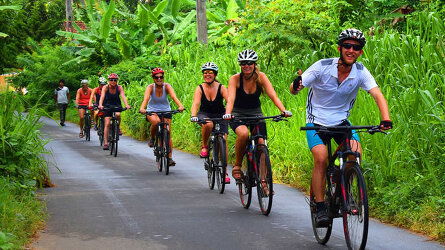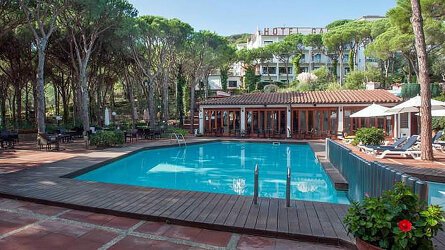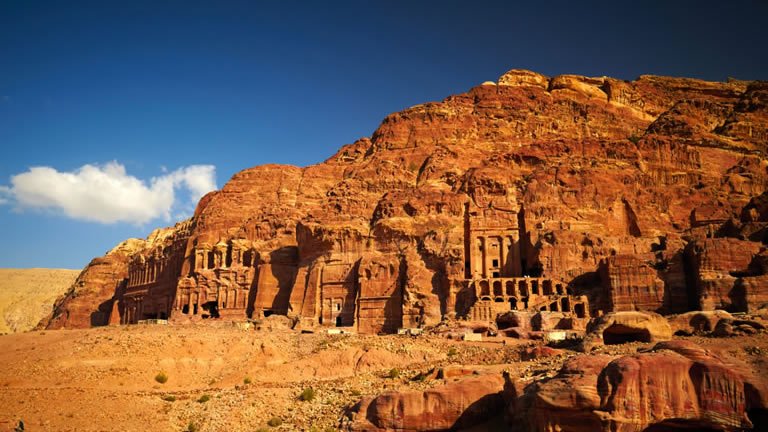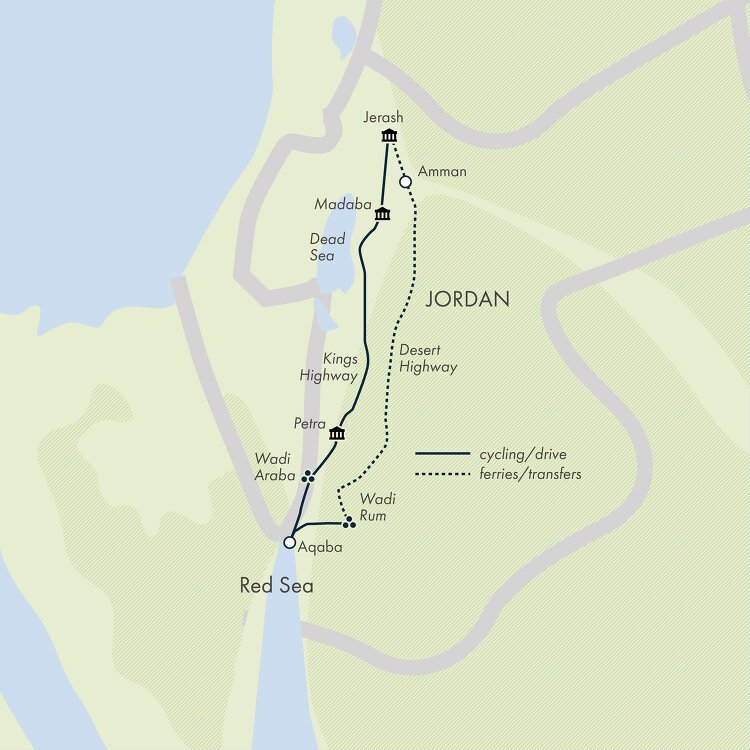Overview
Itinerary
Welcome to Amman, the capital of Jordan, where our adventure begins. There are free transfers to the hotel from Queen Alia International Airport (AMM) for all customers today. Please note, transfers should be booked with your sales representative at least two weeks before the tour starts. Stay: Larsa Hotel (or similar).
After an initial briefing, we transfer by bus for approximately 45 minutes to the ancient city of Jerash. Known in Roman times as Gerasa, Jerash is one of the best-preserved examples of a Roman provincial town in the Middle East. It is a vast site with incredible ruins that enable you to almost visualise Roman life there, from the dramatic chariot races to the everyday bartering along the colonnaded streets.
After a couple of hours absorbing the atmosphere of this incredible site, we return to the bus for a short transfer to the beginning of our ride, having lunch en route. When we arrive we will be introduced to the cycling team and our bikes.
This afternoon we will cycle for approximately 3hr 30min through the foothills of the Jordan Rift Valley. This is the most fertile region in the country and also the most populated. We will wind our way down quiet roads and through small villages taking in the landscapes. The cycling is on good roads and much of the time you will be descending. In places, there may be some loose gravel that you will need to watch out for and there is one fairly long ascent.
You will be briefed about the ride before you set off and the support vehicles will always be on hand. At the end of the ride we will leave the bikes for the day and transfer to Madaba, the City of Mosaics. The bus journey will take approximately two hours. There are several nice restaurants in Madaba, plus cafes and shops selling excellent baklava. Stay: Black Iris Hotel (or similar) (B/L).
This morning we will wake up in Madaba, the City of the Mosaics. Madaba is the most important Christian centre in Jordan and best-known for its Byzantine mosaics. The most important of these is the sixth-century mosaic of Jerusalem and the Holy Land, which covers the floor of the Greek Orthodox church of St George. This morning we can marvel at its detail and natural colour. We then have a short transfer out of the town centre to be reunited with our bikes.
Today's ride starts with a 4. 3mi (7km) mild ascent up Mount Nebo, reputedly the burial site of Moses. We take a pitstop at the top for a spectacular view over the valley below. From here it's a fantastic descent to the shores of the Dead Sea. Parts of this descent are quite steep but support will be at hand and you can take your time. We follow the coast on a smooth, paved surface to Suwaima where we can change and take a float in the waters.
After a shower, it's back on the bus for the long drive south (approximately three hours) along the Kings Highway towards Petra. In many places, the route is spectacular and there will be a couple of stops to admire the view on the way. Stay: Standard hotel – see accommodation section for more detail (B/L).
The so-called Red Rose City was hidden for centuries until the Swiss explorer Johann Ludwig Burckhardt rediscovered it in 1812. It was founded by the Nabateans, an Arab tribe that arrived here in the sixth century BCE. Building at Petra began in the third century BCE and continued through the Roman period, financed by taxes levied on the desert caravans.
Two features of Petra are unique: firstly, it is a city made defensible by being built down a series of chasms, rather than on a hilltop. Secondly, it is built directly into the rock – beautiful red-and-yellow sandstone carved into the most impressive facades, which glow in the sunlight. During our time in Petra we will have the opportunity to explore the site from all angles.
We will walk down the narrow Siq, where a sandstone chasm rises 260ft (80m) either side of us and reveals El Khazneh (the Treasury) as we reach its end. There will also be an opportunity to explore the higher caves and the High Place of Sacrifice for a fantastic panorama of the whole site. At ground level, we pass the houses and tombs of the rich citizens, and the amphitheatre.
A long walk beyond the centre is El Deir (the Monastery) with its superb facade topped by a huge urn. The Monastery is set in a more remote location of the site and there is the option to climb around 800 steps to reach it, but it is well worth it. Stay: Standard hotel – see accommodation section for more detail (B).
In the morning we cycle to the north of the main city to Little Petra and the Siq Al-Barid. A classical temple stands guard outside the miniature siq, which is believed to have been an important suburb to the city of Petra itself. The narrow file, only some 1,148ft (350m) long, is crammed with triclinia, water channels and cisterns. Of particular note are the remains of painted frescoes on plaster dating from the first century CE, which are to be found in one of the biclinia. Overnight in Petra. Stay: Standard hotel – see accommodation section for more detail (B).
It's an early start today to avoid the heat for our first real desert experience.
After a short transfer to Tayba village, we begin riding mostly on paved surfaces to Ar-Rajif. The road cuts through traditional Bedouin territory and is a seasonal stop for the nomadic shepherds of south Jordan so the chance of a local tea break is high. The road is in a good state of repair, with some sections having been recently resurfaced.
However, parts are quite heavily potholed and there is a chance that sand and stones have blown across the road and make for a loose surface, so care should be taken. We head into the desert and follow the road down to Gharandal via Dilagha to Wadi Araba. There are a few ascents and descents and it is our longest and hardest day of riding. However, it is also the most spectacular and rewarding. The road takes you on an amazing journey through the desert and makes for a very satisfying day of riding. This day is all about the cycling allowing us to immerse ourselves in the landscape. After our desert crossing, it's a short drive to Aqaba on the Red Sea. Stay: Lacosta Hotel (or similar) (B).
This morning we have free time to lounge on the beach, swim, or snorkel. The transport and entrance to one of the private beaches is included in your trip. The hire of snorkelling equipment is extra to be paid on the day. In the early afternoon, we will transfer out of town for around 45 minutes and then we will get on the bikes for the last time.
This ride will take us into Wadi Rum on a relatively flat desert road. The desert scenery today is quite different to that experienced yesterday and will evoke a sense of more recent history than what we have been experiencing until now. This is where Lawrence of Arabia and Prince Faisal assembled the Arab tribes for the attack on Aqaba in the first world war and also where sections of the film Lawrence of Arabia (1962) were shot.
Tonight we will experience Bedouin hospitality with a traditional meal, sweet tea and desert camping in goat-hair tents. We will be able to contemplate our week of adventure as we gaze up at the star-lit sky, warmed by a fire. If you like you can pull your mattress outside and sleep under the stars. Stay: private Bedouin camp (B/D).
After breakfast we take a 4x4 into the desert for around two hours.
Following lunch, surrounded by the vastness of the desert and towering rocky outcrops, we transfer back to Amman, a journey of approximately four hours with a stop en route. Stay: Larsa Hotel (or similar) (B).
Breakfast marks our final meal, an excellent chance to reminisce about an adventure packed with excitement. To make your return journey home easier, there's a free shared transfer back to the airport (B).
Trip Inclusions
- Cycle through spectacular desert scenery
- Visit the Unesco-listed site of Petra
- Camp under the stars in Wadi Rum
- 7 Classic nights (hotels), 1 Simple night (Bedouin camp)
- Five days cycling with full vehicle support
- 95 percent quiet paved roads, five percent gravel and sandy roads
- Mainly flat with some steep climbs and hot temperatures
- All breakfasts, two lunches and one dinner
- All transport and listed activities
- Tour leader throughout
- Arrival and departure transfers
- Local bike hire
- Itinerary and inclusions are subject to change
- Price is for land, cruise and internal flights as specified. Flights not specified are not included

From gentle rides through the French countryside to challenging expeditions across Asia & more. Read more

Exodus chooses their Leaders carefully. Professional, dedicated and are passionate about sharing their home countries. Read more

Wherever possible, Exodus chooses properties that are locally owned and that reflect the area you are visiting. Read more
Availability
A definite departure means minimum numbers have been reached for this departure to operate. Your Global Journeys Travel Advisor will check the availability of your departure date when you enquire. Additional savings may apply. We guarantee the lowest price in Australia. T&C’s apply.
Tour & cruises prices are per person. Prices shown have savings applied, are subject to availability and may be withdrawn at any time without notice. Pricing and trip details are correct at this point in time, however are subject to confirmation at the time of booking and are subject to change by Exodus. For cruise itineraries, cabin images are sourced from Exodus. These should be treated as indicative only. Cabin inclusions, upholsteries and room layout may differ to the image(s) shown depending on the ship selected and your sailing dates.









